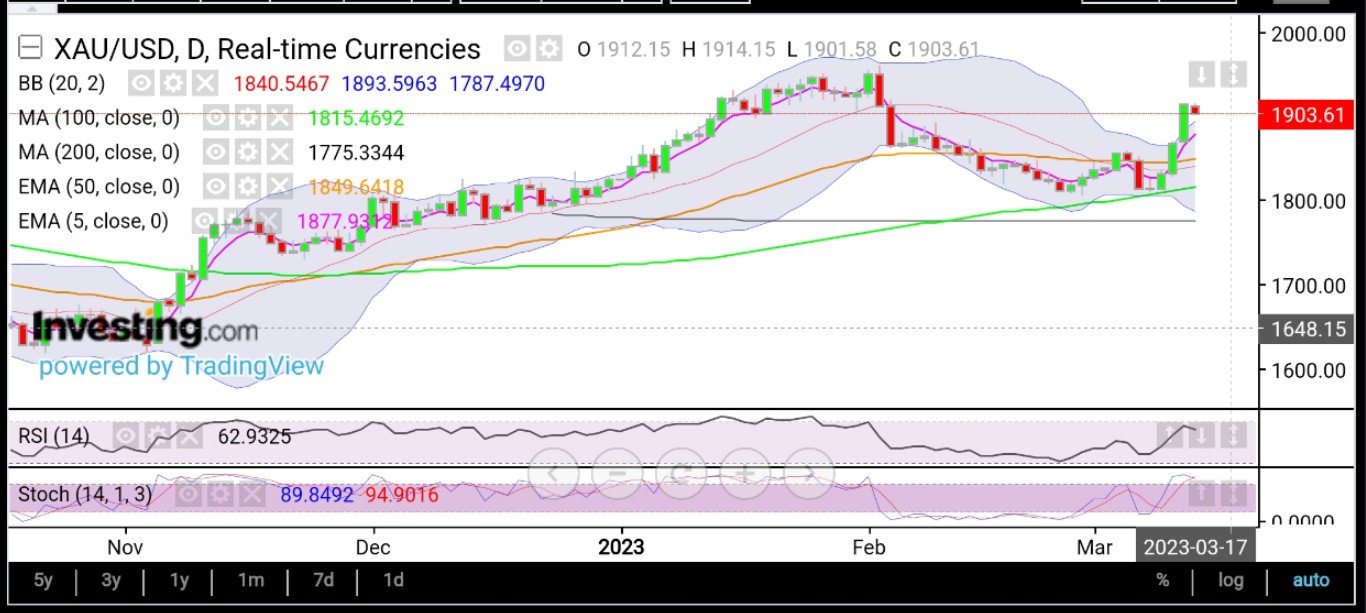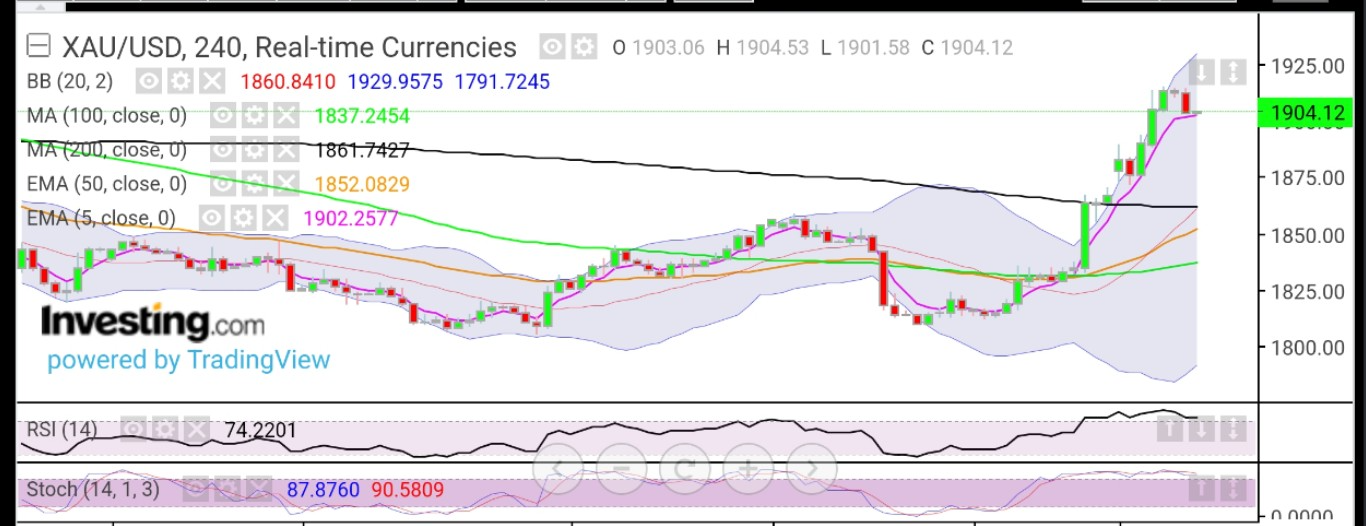- Wall St. argues Fed rate hikes must stop to contain more SVB-like banking crises
- Fed likely to maintain course for a terminal rate of 5.75% vs. a peak of 4.75% now
- Gold longs could be focused on $1,900 as the new normal without running to $2,000 just yet
Just a month ago, on the eve of Valentine’s, I wondered aloud whether gold longs could win some new love on what also happened to be CPI Day. Well, fast forward 30 days, and here we are on another inflation data day.
As my regular technical collaborator Sunil Kumar Dixit pointed out in our previous article on this on Feb. 13, the dollar was on the cusp of a breakout and likely to keep gold range-bound in the mid-$1,800s. But on the flip side, the run-up in the Dollar Index — the contra-trade to gold — may reach exhaustion beyond 105 and set gold on the $1,900 course, Dixit said.
We’re in that flipside situation a month later, though the circumstances seem quite different. We now have what appears to be an emerging banking crisis on top of the base market concern of what the latest monthly inflation was.
Charts by SKCharting.com, with data powered by Investing.com
By the time you read this, the Consumer Price Index for February would’ve probably been reported. If not, here’s the forecast: Headline CPI is expected to have expanded 6% year-on-year in February from 6.4% in January and 0.4% for the month versus a previous 0.5%.
Core CPI, a reading that strips out volatile food and energy prices, is forecast to have risen 5.5% for the year to February from the previous annual reading of 5.6%. Month-on-month, the core number is expected to be flat at 0.4%.
Notwithstanding the CPI data, there’s a growing feeling that the fallout emanating from the collapse of California-based Silicon Valley Bank — a crisis now known by the shorthand SVB — might be stickier than thought, despite the Biden administration’s determination to prevent any contagion.
Worse, much of Wall Street seems to believe — not altruistically, I’ll add — that the SVB crisis will be more influential than inflation in determining Federal Reserve policy in the near future.
Put simply, the big movers and shakers on the stock market are using the banking fallout as a backdrop to demand that the Fed do limited or no more monetary tightening until the central bank is certain that the economy is sound, and it won’t accelerate the country towards a recession.
Fed officials argue that they have the tools to mitigate any SVB-related contagion (at least one other bank has been taken over by the FDIC) and it’s more important that the fight against inflation continues with more rate hikes.
President Joe Biden’s first agenda on Monday morning was to assure that the deposits of Americans in SVB and other banks were safe, guaranteed by the Federal Deposit Insurance Corp. or FDIC.
Biden also vowed not to let the banking debacle develop into a financial crisis, and ordered an investigation of the SVB collapse — something the Fed followed up on later in the day when it pledged a thorough, transparent and swift review.
Despite the assurances, investors' minds seem to have been made up that the SVB crisis is a red flag for the Fed to stop rate hikes — the argument is that 450 basis points is adequate for a year, despite inflation remaining more than three times above the central bank’s annual 2% target.
If the Fed kept the pressure up on rates, more banks are likely to fail was the caution circulating in markets on Monday.
The Fed is unlikely to capitulate to such emotional blackmail, if you will, and would probably stay the course towards a terminal rate of 5.75% versus the current 4.75% peak for rates.
But the long-gold crowd — like the long-equities crowd — has also made up its mind that the banking crisis would grow if the Fed did not back off. As a measure of gold’s renewed safe-haven status amid the SVB debacle, the yellow metal reached a six-week high on Monday.
The front-month April gold futures contract on New York’s Comex settled at $1,916.40 an ounce, up $49.30, or 2.6%. The session high was $1,919.20, a peak since the $1,959.10 registered on Feb. 2.
The spot price of gold, more closely followed than futures by some traders, settled at $1,913.23, up $35.37, or 1.9% on the day. The session high for spot gold was $1,914.79.
The rally has given rise to the notion that $1,900 could be the new normal for now for gold, though few are immediately betting on a new record high above $2,000.
Forecasting the likely trek of the spot price, gold strategist Tammy Da Costa said in a blog on the DailyFX site that a move above $1,910 could drive bullion to $1,930.
Analysts at ANZ Bank add in a separate outlook:
“Gold price broke the key resistance of $1,845 following rise in US unemployment number and collapse of Silicon Valley Bank on Friday. This suggests that bullish momentum is likely to continue, however, one should be cautious of a false breakout. Gold needs to trade high to continue this momentum.”

Dixit, on his part, said Monday’s rally has left the RSI, or Relative Strength Index, of spot gold on the 4-Hour chart extremely overbought at 82.80. He adds:
“This causes some natural pull back towards support areas for regaining energy from unwinding of weak shorts.”
“The prevailing uptrend remains intact as long as prices sustain above the $1,878 key support, and a pull back towards the support areas of $1,893-$1,888 will be a value buying zone for the resumption of the uptrend targeting $1,928.”
“If momentum shows strength above 1928, the ongoing rally will retest swing high of $1,960.”
On the other end of the divide, sustainability below the $1,893-$1,888 level will push spot gold down towards the $1,878-$1,868 level, he said, adding:
“Below this sits the 50-Day EMA, or Exponential Moving Average, of $1,850, which is the next decisive support and demand zone.”
Disclaimer: Barani Krishnan uses a range of views outside his own to bring diversity to his analysis of any market. For neutrality, he sometimes presents contrarian views and market variables. He does not hold positions in the commodities and securities he writes about.
